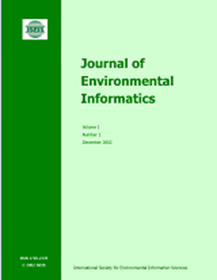将最优极限生态曲线纳入梯级水电系统运行图以减轻极端水文条件下的生态破坏
IF 5.4
1区 环境科学与生态学
Q1 ENVIRONMENTAL SCIENCES
引用次数: 12
摘要
大多数水电站的生态运行图关注的是长期的平均生态效益,而往往忽略或忽略了水旱可能造成的生态破坏。本文提出了一种新的梯级水电站水电生态运行图,通过引入有限的生态曲线进行优化,在不减少发电量的情况下,缓解旱涝事件对鱼类栖息地的负面影响,保持长期平均栖息地质量。利用物理生境模拟模型,由加权可用面积-流量曲线确定给定生态保护目标下的最优生态流量范围,通过反求得到生态上限和下限曲线,并与常规运行图(COC)组成生态运行图(EOC)。以降低干湿极端生态破坏频率为目标,进一步优化有限生态曲线,并将其纳入COC,形成优化生态运行图(OEOC)。以沅江贾沙江(JS)和马独山(MDS)梯级水库为例进行了研究。研究结果表明,考虑生态效益的生态补偿比COC能降低生态破坏频率,但可能以牺牲整体生态效益为代价。然而,对OEOC有限生态曲线的进一步优化,有可能以较低的整体生态效益为代价,获得较高的短期生态效益和较低的生态破坏频率。具体而言,OEOC有助于降低生态破坏频率,提高发电量和整体生态效益,达到60 ~ 80%的生态目标。值得注意的是,在80%的生态目标下,与COC相比,OEOC使JS-MDS梯级水库的发电量增加了4.1%,生态破坏频率降低了11.25%。本文章由计算机程序翻译,如有差异,请以英文原文为准。
Incorporation of Optimal Limited Ecological Curves into the Operation Chart of Cascade Hydropower Systems to Alleviate Ecological Damages in Hydrological Extremes
Most ecological operation charts of hydropower stations have focused on the average ecological benefits over a long period of time, while the possible ecological damage caused by flood or drought is often overlooked or averaged out. This study proposed a new hydropower-ecological operation chart of cascade hydropower stations, in which limited ecological curves were introduced and optimized to alleviate the negative impacts caused by drought or flood events on fish habitat and to maintain the long-term average habitat quality without reducing the power generation. The optimal ecological discharge range at a given ecological conservation target was determined from the weighted usable area-discharge curve using the physical habitat simulation model, and then the upper and lower limited ecological curves were obtained by reverse calculation, which together with the conventional operation chart (COC) formed the ecological operation chart (EOC). The limited ecological curves were further optimized with the goal of reducing the ecological damage frequency in wet and dry extremes, and then incorporated into COC to form the optimized ecological operation chart (OEOC). A case study was performed with Jasajiang (JS) and Madushan (MDS) cascade reservoirs on the Yuan River in southwestern China. The results show that the EOC that takes into account the ecological benefits can reduce the ecological damage frequency compared to the COC, but potentially at the expense of the overall ecological benefit. However, further optimization of limited ecological curves in OEOC makes it possible to obtain higher short-term ecological benefit and lower ecological damage frequency with the loss of lower overall ecological benefit. Specifically, OEOC is helpful to reduce the ecological damage frequency and improve the power generation and overall ecological benefit at an ecological target of 60 ~ 80%. Notably, at an ecological target of 80%, OEOC results in a 4.1% increase in power generation and a 11.25% decrease in ecological damage frequency for JS-MDS cascade reservoirs compared with that of COC, respectively.
求助全文
通过发布文献求助,成功后即可免费获取论文全文。
去求助
来源期刊

Journal of Environmental Informatics
ENVIRONMENTAL SCIENCES-
CiteScore
12.40
自引率
2.90%
发文量
7
审稿时长
24 months
期刊介绍:
Journal of Environmental Informatics (JEI) is an international, peer-reviewed, and interdisciplinary publication designed to foster research innovation and discovery on basic science and information technology for addressing various environmental problems. The journal aims to motivate and enhance the integration of science and technology to help develop sustainable solutions that are consensus-oriented, risk-informed, scientifically-based and cost-effective. JEI serves researchers, educators and practitioners who are interested in theoretical and/or applied aspects of environmental science, regardless of disciplinary boundaries. The topics addressed by the journal include:
- Planning of energy, environmental and ecological management systems
- Simulation, optimization and Environmental decision support
- Environmental geomatics - GIS, RS and other spatial information technologies
- Informatics for environmental chemistry and biochemistry
- Environmental applications of functional materials
- Environmental phenomena at atomic, molecular and macromolecular scales
- Modeling of chemical, biological and environmental processes
- Modeling of biotechnological systems for enhanced pollution mitigation
- Computer graphics and visualization for environmental decision support
- Artificial intelligence and expert systems for environmental applications
- Environmental statistics and risk analysis
- Climate modeling, downscaling, impact assessment, and adaptation planning
- Other areas of environmental systems science and information technology.
 求助内容:
求助内容: 应助结果提醒方式:
应助结果提醒方式:


